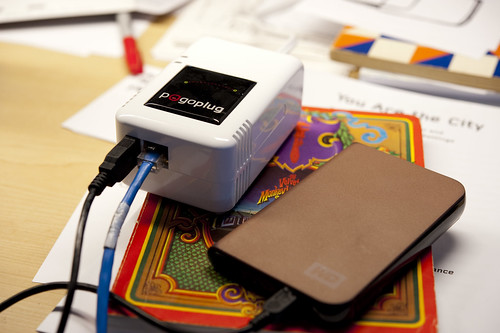
BTW lying under the tech is a first edition (1973) of the brilliantly quirky and prescientThe Velvet Monkey Wrench
Along with Augmented Reality, Cloud Computing seems to be one of the more thorough-going technology memes these days. The concept is consistent with the logic of the network. As bandwidth speeds level-up, and bandwidth costs go down (not free, just less, despite what Chris Anderson hypes) the asymptotic extreme approaches a curious quandary: where should “processing” be placed in relation to “data”?
Imagine if data can move (or appear to move) fast enough between where it is consumed and created such that it doesn’t actually matter where it lives? That might mean that I don’t have to lug around lots of big portable computing power — I can use a svelte device with just a sliver of CPU and enough screen to see what I need to see. No hot, power-hungry hard drive. Etc.
I’m curious about this intersecting graph and so decided to introduce an experiment using this newly available Pogoplug device. Effectively it’s a condensed bit of pre-existing technology wonderfully packaged into simple oneness. Simple oneness — my half-assed way to describe the Pogoplug without referring to it as either “smart”, as an “appliance” or a “smart appliance.” It’s only smart in the degree to which it does not make me feel dumb.
I have to say, it certainly appears clever in a number of ways. First of all, it does something obvious, and I mean that this way: the bits of technical kit required to make ones data appear close to one no matter where one is, within the constraints of reasonable access to networks and so forth — this has been around for quite some time. I can remember — and I’m sure every geek with an itch to not just speculate but live a bit in the future — I can remember cobbling together this and that to get my screen, my data and my command prompt to appear and be accessible from other places. It was all there, all the little packages and so forth — it was just an unpleasant, distasteful peasants stew. Pogoplug adds some robust seasoning. I didn’t have to touch a thing except to plug everything together, copy a unique identifier found in the box into a web form — and the Pogoplug mothership found my unit, prompted me to pick a username and password and then I saw a web interface to all the drives I had plugged into the unit. Nice, simple, surprising.
There’s a bit of software for Windows and OS X to allow the drives to appear like ordinary desktop storage, making drag-and-drop and browsing quite familiar. I can assign files to be shared to specific people — there are no global permissions it appears, which is just fine with me. Although, one interesting aspect of this is a possible shift in the locality of served data. I’m curious about this — rather than data living in the more typical, canonical places like data centers, does it distribute in a fashion, so that your data is accessed at its place of origin, or where you decide to keep it and perhaps you like to keep it close by or even under your mattress or the equivalent in the networked age. And perhaps it is served up and processed more locally, such as at my home, in my car’s computer, directly from my mobile computer or mobile phone or even from my camera.
It’s just a speculation, but a more distributed network of nodes is a peculiar inversion of the typical run and hype of cloud-y things, which implores us to move everything into one or two or many clouds run by cloud service providers. What about an infinity of highly localized service points? What about my front doormat? Should it be a service provider? Can the guys who insist on bringing door hanger adverts for the local Thai restaurant just upload it to my door handle instead? Save the paper? Can I unsubscribe to the inevitable digital version of the crappy real estate newspaper that appears on the lawn in the morning?
I don’t know the specific advantages this might offer when measured against the usual metrics of the technology business — faster, cheaper, more profitable — but I enjoy the concept of keeping my stuff — data, touch points, access ways — close to me, nearby, on me, in my devices, etc. There are times when I feel like I am too trusting when I put it off somewhere I don’t even have physical access to. Perhaps my furniture secures my stuff, hidden in the overstuffed arm rest of my reading chair or something?
Continue reading Pogoplug and The Rise of Network Fog



